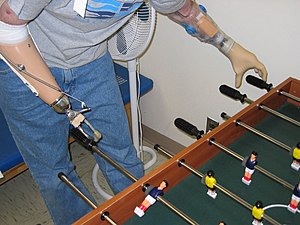
- Image via Wikipedia
Businesses in the South Park district of San Francisco generally sell either Web technology or sandwiches and burritos. Bespoke Innovations plans to sell designer body parts.
The company is using advances in a technology known as 3-D printing to create prosthetic limb casings wrapped in embroidered leather, shimmering metal or whatever else someone might want.
Scott Summit, a co-founder ofBespoke, and his partner, an orthopedic surgeon, are set to open a studio this fall where they will sell the limb coverings and experiment with printing entire customized limbs that could cost a tenth of comparable artificial limbs made using traditional methods. And they will be dishwasher-safe, too.
“I wanted to create a leg that had a level of humanity,” Mr. Summit said. “It’s unfortunate that people have had a product that’s such a major part of their lives that was so underdesigned.”
A 3-D printer, which has nothing to do with paper printers, creates an object by stacking one layer of material — typically plastic or metal — on top of another, much the same way a pastry chef makes baklava with sheets of phyllo dough.
The technology has been radically transformed from its origins as a tool used by manufacturers and designers to build prototypes.
These days it is giving rise to a string of never-before-possible businesses that are selling iPhone cases, lamps, doorknobs, jewelry, handbags, perfume bottles, clothing and architectural models. And while some wonder how successfully the technology will make the transition from manufacturing applications to producing consumer goods, its use is exploding.
A California start-up is even working on building houses. Its printer, which would fit on a tractor-trailer, would use patterns delivered by computer, squirt out layers of special concrete and build entire walls that could be connected to form the basis of a house.
It is manufacturing with a mouse click instead of hammers, nails and, well, workers. Advocates of the technology say that by doing away with manual labor, 3-D printing could revamp the economics of manufacturing and revive American industry as creativity and ingenuity replace labor costs as the main concern around a variety of goods.
“There is nothing to be gained by going overseas except for higher shipping charges,” Mr. Summit said.
A wealth of design software programs, from free applications to the more sophisticated offerings of companies including Alibre and Autodesk, allows a person to concoct a product at home, then send the design to a company like Shapeways, which will print it and mail it back.
“We are enabling a class of ordinary people to take their ideas and turn those into physical, real products,” said J. Paul Grayson, Alibre’s chief executive. Mr. Grayson said his customers had designed parts for antique cars, yo-yos and even pieces for DNA analysis machines.
“We have a lot of individuals going from personal to commercial,” Mr. Grayson said.
Related articles by Zemanta
- US Army Finds 3D Printing + Shipping Container = Instant Parts (treehugger.com)









